Energy Efficiency and Thermal Comfort Analysis in a Higher Education Building in Brazil
Abstract
1. Introduction
2. Literature Review
2.1. Energy Labelling for Buildings in Brazil
2.2. Indoor Thermal Comfort
2.3. Occupant Behaviour
3. Materials and Methods
3.1. RTQ-C Prescriptive Method
- PT is the total score;
- EqNumEnv is the numerical equivalent of the envelope;
- EqNumDPI is the numerical equivalent of the lighting system;
- EqNumCA is the numerical equivalent of the air-conditioning system;
- EqNumV is the numerical equivalent of unconditioned zones;
- APT is the floor area of non-conditioned transitory permanence zones;
- ANC is the floor area of long-term non-conditioned zones;
- AC is the floor area of conditioned zones;
- AU is the usable area;
- b is the score obtained by the bonuses, which can vary from 0 to 1.
3.2. Building Description (Geometry, Envelope, Lighting, and Air Conditioning)
3.3. Climate Region
3.4. Thermal Comfort Analysis
3.4.1. On-Site Measurements
3.4.2. Questionnaires
3.4.3. Survey Study
4. Results
4.1. RTQ-C Energy Efficiency Labelling
4.2. Thermal Comfort
4.2.1. Classroom Survey Results
4.2.2. PMV/PPD of the Classrooms
4.2.3. Office Rooms
4.2.4. PMV/PPD—Office Rooms
- (a)
- The PMV of offices (Table 11) was higher, more than double the PMV of CL1 and CL2;
- (b)
- The variability in the PMV (measured by the coefficient of variation: C.V.) for the offices (C.V. = 94.23%) was much lower than those for CL1 (C.V. = 322%) and CL2 (C.V. = 888%);
- (c)
- The PPDs (predicted percentages of dissatisfied) for the offices were very similar to those for CL1, although significantly lower than for CL2;
- (d)
- The Iclo-clo values of all rooms were very similar, around 0.5.
- (i)
- The air conditioning in the offices is older, with worse performance than that in CL1 and CL2. In addition, the worse behaviour of office occupants related to opening and closing the windows explains the results described in item (a) above;
- (ii)
- The gender representation in CL1 and CL2 contains fewer women (34%) and an average age of 29.4 years, while, in offices, women are the majority (62%), with an average age of 45.7 years. These significant differences (gender and age) among the groups of occupants are a possible source of the variability in the PMV in offices, as highlighted in item (b) above;
- (iii)
- As mentioned before, CL2 has higher exposure to solar irradiance since it is below the roof of the building (Figure 2b, block J). Furthermore, the material construction of the roof of building 2 is concrete slab and fibre cement tile with high thermal transfer parameters. This explains the higher PPD (predicted percentage of dissatisfied) for CL2 compared to the offices and CL1 (intermediate floor), which was highlighted in item (c) above;
- (iv)
- The effect of clothing did not influence thermal comfort in these selected indoor spaces, since for all rooms (CL1, CL2, and offices), the occupants’ daily habits were well adapted to climate conditions during warm periods. They are familiar with the proper clothing for these spaces. This can explain the very similar Icl-clo values for all rooms, as shown in Table 11 and highlighted in item (d) above.
5. Conclusions
- (i)
- The inappropriate capacity of the air-conditioning equipment related to the environment;
- (ii)
- The inappropriate use of the air-conditioning equipment;
- (iii)
- The inappropriate use of construction technologies (opening and closing windows and doors);
- (iv)
- The need to improve and simplify user ability to change the equipment setpoint;
- (v)
- Allowing the change of the worktable position inside the offices to achieve better performance and thermal comfort for users;
- (vi)
- The location, types, and quality of materials.
Author Contributions
Funding
Institutional Review Board Statement
Informed Consent Statement
Data Availability Statement
Acknowledgments
Conflicts of Interest
References
- International Energy Agency (IEA). World Energy Outlook 2022; IEA: Paris, France, 2022. [Google Scholar]
- Kong, X.-F.; Lü, S.-L.; Xin, Y.-J.; Wu, W. Energy consumption, indoor environmental quality, and benchmark for office buildings in Hainan Province of China. J. Central South Univ. Technol. 2012, 19, 783–790. [Google Scholar] [CrossRef]
- Li, D.H.; Yang, L.; Lam, J.C. Zero energy buildings and sustainable development implications—A review. Energy 2013, 54, 1–10. [Google Scholar] [CrossRef]
- Skillington, K.; Crawford, R.H.; Warren-Myers, G.; Davidson, K. A review of existing policy for reducing embodied energy and greenhouse gas emissions of buildings. Energy Policy 2022, 168, 112920. [Google Scholar] [CrossRef]
- Antoniadou, P.; Papadopoulos, A.M. Occupants’ thermal comfort: State of the art and the prospects of personalized assessment in office buildings. Energy Build. 2017, 153, 136–149. [Google Scholar] [CrossRef]
- Fossati, M.; Scalco, V.A.; Linczuk, V.C.C.; Lamberts, R. Building energy efficiency: An overview of the Brazilian residential labeling scheme. Renew. Sustain. Energy Rev. 2016, 65, 1216–1231. [Google Scholar] [CrossRef]
- Zhang, J.; Li, P.; Ma, M. Thermal Environment and Thermal Comfort in University Classrooms during the Heating Season. Buildings 2022, 12, 912. [Google Scholar] [CrossRef]
- United Nations Environment Programme-UNEP, Greening Universities Toolkit:Transforming Universities into Green and Sustainable Campuses, 2013. Available online: https://wedocs.unep.org/bitstream/handle/20.500.11822/11273/Greening_unis_toolkit_Single_Page.pdf?sequence=1&isAllowed=y (accessed on 18 September 2023).
- Martínez-Acosta, M.; Vázquez-Villegas, P.; Mejía-Manzano, L.A.; Soto-Inzunza, G.V.; Ruiz-Aguilar, K.M.; Cuellar, K.L.; Caratozzolo, P.; Membrillo-Hernández, J. The implementation of SDG12 in and from higher education institutions: Universities as laboratories for generating sustainable cities. Front. Sustain. Cities 2023, 5. [Google Scholar] [CrossRef]
- Aver, B.; Fošner, A.; Alfirevic, N. Higher Education Challenges: Developing Skills to Address Contemporary Economic and Sustainability Issues. Sustainability 2021, 13, 12567. [Google Scholar] [CrossRef]
- Dawodu, A.; Dai, H.; Zou, T.; Zhou, H.; Lian, W.; Oladejo, J.; Osebor, F. Campus sustainability research: Indicators and dimensions to consider for the design and assessment of a sustainable campus. Heliyon 2022, 8, e11864. [Google Scholar] [CrossRef]
- University of Campinas Sustainable Campus Project. Available online: https://campus-sustentavel.unicamp.br/en/home-2/ (accessed on 12 August 2023).
- Ruas, A.C. Systematization of Thermal Comfort Assessment in Built Environments and Its Application in Software. Comfort Program 2.03., Updated version provided by the author in 2018 School of Civil Engineering, Architecture and Urbanism; University of Campinas—Unicamp: Campinas, Brazil, 2018. [Google Scholar]
- Moore, C.; Shrestha, S.; Gokarakonda, S. Building energy standards and labelling in Europe. Hospitals 2019, 70, 85. [Google Scholar]
- BRASIL Instituto Nacional de Metrologia Normalização e Qualidade Industrial Portaria 372, de 17 de Setembro de 2010.
- Regulamento Técnico da Qualidade para o Nível de Eficiência Energética de Edificações Comerciais, de Serviços e Públicas; INMETRO: Rio de Janeiro, Brazil, 2010. Available online: http://www.inmetro.gov.br/legislacao/rtac/pdf/rtac001599.pdf (accessed on 11 July 2023).
- Batista, N.D.N.; La Rovere, E.L.; Aguiar, J.C.R. Energy efficiency labeling of buildings: An assessment of the Brazilian case. Energy Build. 2010, 43, 1179–1188. [Google Scholar] [CrossRef]
- Lopes, M.; Iwamoto, G.; Riella, H.; Lamberts, R.; Campos, L. The Building Simulation as an Alternative Method in Brazilian Energy Efficiency Labelling Commercial Buildings. In Proceedings of the 12 h Conference of International Building Perfor-mance Simulation Association, IBPSA, Sydney, Australia, 14–16 November 2011; pp. 2055–2063. [Google Scholar]
- BRASIL. Ministério do Planejamento Orçamento e Gestão Instrução Normativa No 2, de 4 de Junho de 2014; Diário Oficial [da] República Federativa do Brasil: Brasília, DF, Brazil, 2014. [Google Scholar]
- Tomazi, J.O.; Rodrigues, L.J.; Schneider, P.S. Auditoria energética visando o selo procel de economia de energia para uma Edificação pública de ensino/energy audit aiming at the procel seal of energy savings for a public education building. Brazilian Journal of Development. 2020, 6, 99648–99664. [Google Scholar] [CrossRef]
- Pereira, J.; Rivero, C.C.; Gomes, M.G.; Rodrigues, A.M.; Marrero, M. Energy, environmental and economic analysis of windows’ retrofit with solar control films: A case study in Mediterranean climate. Energy 2021, 233, 121083. [Google Scholar] [CrossRef]
- Tong, S.W.; Goh, W.P.; Huang, X.; Jiang, C. A review of transparent-reflective switchable glass technologies for building facades. Renew. Sustain. Energy Rev. 2021, 152, 111615. [Google Scholar] [CrossRef]
- Grynning, S.; Gustavsen, A.; Time, B.; Jelle, B.P. Windows in the buildings of tomorrow: Energy losers or energy gainers? Energy Build. 2013, 61, 185–192. [Google Scholar] [CrossRef]
- De Moraes, C.S.; da Fonseca, A.L.A. Automação Predial: Tecnologia e Gestão Em Prol Da Eficiência Energética Em Prédios Públicos. In Proceedings of the Encontro Nacional de Conforto no Ambiente Construído, 15, João Pessoa, Brazil, 18–20 September 2019; Ed. ANTAC. pp. 2216–2225. [Google Scholar]
- Homod, R.Z.; Almusaed, A.; Almssad, A.; Jaafar, M.K.; Goodarzi, M.; Sahari, K.S.M. Effect of different building envelope materials on thermal comfort and air- energy savings: A case study in Basra city, Iraq. J. Energy Storage 2020, 34, 101975. [Google Scholar] [CrossRef]
- Trgala, K.; Pavelek, M.; Wimmer, R. Energy performance of five different building envelope structures using a modified Guarded Hot Box apparatus—Comparative analysis. Energy Build. 2019, 195, 116–125. [Google Scholar] [CrossRef]
- Spinelli, R.; Pitol, A.F.; Pasquali, P.H.D.; Cambeiro, F.P.; Konrad, O. Energy Efficiency Assessment of the Involvement of an Educational Building using the Prescription Method (RTQ-C). Int. J. Adv. Eng. Res. Sci. 2019, 6, 499–510. [Google Scholar] [CrossRef][Green Version]
- Wong, I.L.; Krüger, E. Comparing energy efficiency labelling systems in the EU and Brazil: Implications, challenges, barriers and opportunities. Energy Policy 2017, 109, 310–323. [Google Scholar] [CrossRef]
- Melo, A.; Sorgato, M.; Lamberts, R. Building energy performance assessment: Comparison between ASHRAE standard 90.1 and Brazilian regulation. Energy Build. 2014, 70, 372–383. [Google Scholar] [CrossRef]
- Melo, A.; Versage, R.; Sawaya, G.; Lamberts, R. A novel surrogate model to support building energy labelling system: A new approach to assess cooling energy demand in commercial buildings. Energy Build. 2016, 131, 233–247. [Google Scholar] [CrossRef]
- Hien, W.N.; Jusuf, S.K. An Assessment Method for Existing Greenery Conditions in a University Campus. Arch. Sci. Rev. 2008, 51, 212–222. [Google Scholar] [CrossRef]
- De Giuli, V.; Da Pos, O.; De Carli, M. Indoor environmental quality and pupil perception in Italian primary schools. Build. Environ. 2012, 56, 335–345. [Google Scholar] [CrossRef]
- Bavaresco, M.V.; Ghisi, E.; D’Oca, S.; Pisello, A.L. Triggering occupant behaviour for energy sustainability: Exploring subjective and comfort-related drivers in Brazilian offices. Energy Res. Soc. Sci. 2021, 74, 101959. [Google Scholar] [CrossRef]
- ISO 7730. Available online: https://www.iso.org/standard/39155.html (accessed on 10 February 2023).
- Elnaklah, R.; Ayyad, Y.; Alnusairat, S.; AlWaer, H.; AlShboul, A. A Comparison of Students’ Thermal Comfort and Perceived Learning Performance between Two Types of University Halls: Architecture Design Studios and Ordinary Lecture Rooms during the Heating Season. Sustainability 2023, 15, 1142. [Google Scholar] [CrossRef]
- Zomorodian, Z.S.; Tahsildoost, M.; Hafezi, M. Thermal comfort in educational buildings: A review article. Renew. Sustain. Energy Rev. 2016, 59, 895–906. [Google Scholar] [CrossRef]
- Mishra, A.K.; Ramgopal, M. Field studies on human thermal comfort—An overview. Build. Environ. 2013, 64, 94–106. [Google Scholar] [CrossRef]
- Faraji, A.; Rashidi, M.; Rezaei, F.; Rahnamayiezekavat, P. A Meta-Synthesis Review of Occupant Comfort Assessment in Buildings (2002–2022). Sustainability 2023, 15, 4303. [Google Scholar] [CrossRef]
- Schweiker, M.; Brasche, S.; Bischof, W.; Hawighorst, M.; Wagner, A. Explaining the individual processes leading to adaptive comfort: Exploring physiological, behavioural and psychological reactions to thermal stimuli. J. Build. Phys. 2013, 36, 438–463. [Google Scholar] [CrossRef]
- Guevara, G.; Soriano, G.; Mino-Rodriguez, I. Thermal comfort in university classrooms: An experimental study in the tropics. Build. Environ. 2020, 187, 107430. [Google Scholar] [CrossRef]
- Singh, M.K.; Ooka, R.; Rijal, H.B.; Kumar, S.; Kumar, A.; Mahapatra, S. Progress in thermal comfort studies in classrooms over last 50 years and way forward. Energy Build. 2019, 188–189, 149–174. [Google Scholar] [CrossRef]
- Mamani, T.; Herrera, R.F.; Rivera, F.M.-L.; Atencio, E. Variables That Affect Thermal Comfort and Its Measuring Instruments: A Systematic Review. Sustainability 2022, 14, 1773. [Google Scholar] [CrossRef]
- Wargocki, P.; Wyon, D.P. Providing better thermal and air quality conditions in school classrooms would be cost-effective. Build. Environ. 2013, 59, 581–589. [Google Scholar] [CrossRef]
- Sorgato, M.; Melo, A.; Lamberts, R. The effect of window opening ventilation control on residential building energy consumption. Energy Build. 2016, 133, 1–13. [Google Scholar] [CrossRef]
- Hax, D.R.; Leitzke, R.K.; da Silva, A.C.S.B.; da Cunha, E.G. Influência do Comportamento do Usuário no Consumo de Energia em um Prédio de Ensino Público Na Zona Bioclimática. In Proceedings of the Encontro Nacional de Conforto no Ambiente Construído, 16; ANTAC, Palmas, Brazil, 20–23 October 2021; pp. 1391–1400. [Google Scholar]
- Rashidzadeh, Z.; Matin, N.H. A Comparative Study on Smart Windows Focusing on Climate-Based Energy Performance and Users’ Comfort Attributes. Sustainability 2023, 15, 2294. [Google Scholar] [CrossRef]
- Hu, S.; Yan, D.; Azar, E.; Guo, F. A systematic review of occupant behavior in building energy policy. Build Environ. 2020, 175, 106807. [Google Scholar] [CrossRef]
- Fanger, P.O. Thermal Comfort: Analysis and Application in Environmental Engineering; McGraw-Hill: New York, NY, USA, 1972. [Google Scholar]
- Delzendeh, E.; Wu, S.; Lee, A.; Zhou, Y. The impact of occupants’ behaviours on building energy analysis: A research review. Renew. Sustain. Energy Rev. 2017, 80, 1061–1071. [Google Scholar] [CrossRef]
- Holanda, M.R.A. Influência da Definição do Setpoint do Ar-Condicionado Para o Conforto Térmico e Consumo Energético Em Clima Quente e Úmido; Universidade Federal de Alagoas—UFAL: Maceió, Brazil, 2020. [Google Scholar]
- Hoyt, T.; Arens, E.; Zhang, H. Extending air temperature setpoints: Simulated energy savings and design considerations for new and retrofit buildings. Build. Environ. 2015, 88, 89–96. [Google Scholar] [CrossRef]
- Peel, M.C.; Finlayson, B.L.; McMahon, T.A. Updated world map of the Köppen-Geiger climate classification. Hydrol. Earth Syst. Sci. 2007, 11, 1633–1644. [Google Scholar] [CrossRef]
- Centro de Pesquisas Meteorológicas e Climáticas Aplicadas à Agricultura (CEPAGRI) Climatologia Campinas. Available online: https://www.cpa.unicamp.br/graficos (accessed on 7 October 2023).
- ANSI/ASHRAE 55; Thermal Environmental Conditions for Human Occupancy. American Society for Heating, Refrigerating and Air Conditioning Engineers, Inc.: Atlanta, GA, USA, 2017.
- Brager, G.; Baker, L. Occupant satisfaction in mixed-mode buildings. Build. Res. Inf. 2009, 37, 369–380. [Google Scholar] [CrossRef]
- Lucas, R.E.C.; Da Silva, L.B. Conforto ambiental em sala de aula: Análise da percepção térmica dos estudantes de duas regiões e estimação de zonas de conforto. Rev. Produção Online 2017, 17, 804–827. [Google Scholar] [CrossRef][Green Version]
- Parra, A.L. Qual a Temperatura Ideal Para o Ar-Condicionado Consumir Menos Energia? Gazeta do Povo. Autoria da Jornalista (Luciana Belin). Available online: https://www.gazetadopovo.com.br/haus/sustentabilidade/qual-temperatura-ideal-ar-condicionado-consumir-menos-energia/ (accessed on 10 February 2023).
- Alghamdi, S.; Tang, W.; Kanjanabootra, S.; Alterman, D. Field investigations on thermal comfort in university classrooms in New South Wales, Australia. Energy Rep. 2023, 9, 63–71. [Google Scholar] [CrossRef]
- Jing, S.; Lei, Y.; Wang, H.; Song, C.; Yan, X. Thermal comfort and energy-saving potential in university classrooms during the heating season. Energy Build. 2021, 202, 109390. [Google Scholar] [CrossRef]
- Nico, M.A.; Liuzzi, S.; Stefanizzi, L. Evaluation of thermal comfort in university classrooms through objective approach and subjective preference analysis. Appl. Ergon. 2015, 48, 111–120. [Google Scholar] [CrossRef]
- Hamzah, B.; Ishak, M.T.; Beddu, S.; Osman, M.Y. Thermal comfort analyses of naturally ventilated university classrooms. Struct. Surv. 2016, 34, 427–445. [Google Scholar] [CrossRef]
- Niza, I.L.; da Luz, I.M.; Broday, E.E. Thermal Comfort Assessment in University Classrooms: A Discriminant Analysis for Categorizing Individuals According to Gender and Thermal Preferences. Atmosphere 2023, 14, 1325. [Google Scholar] [CrossRef]
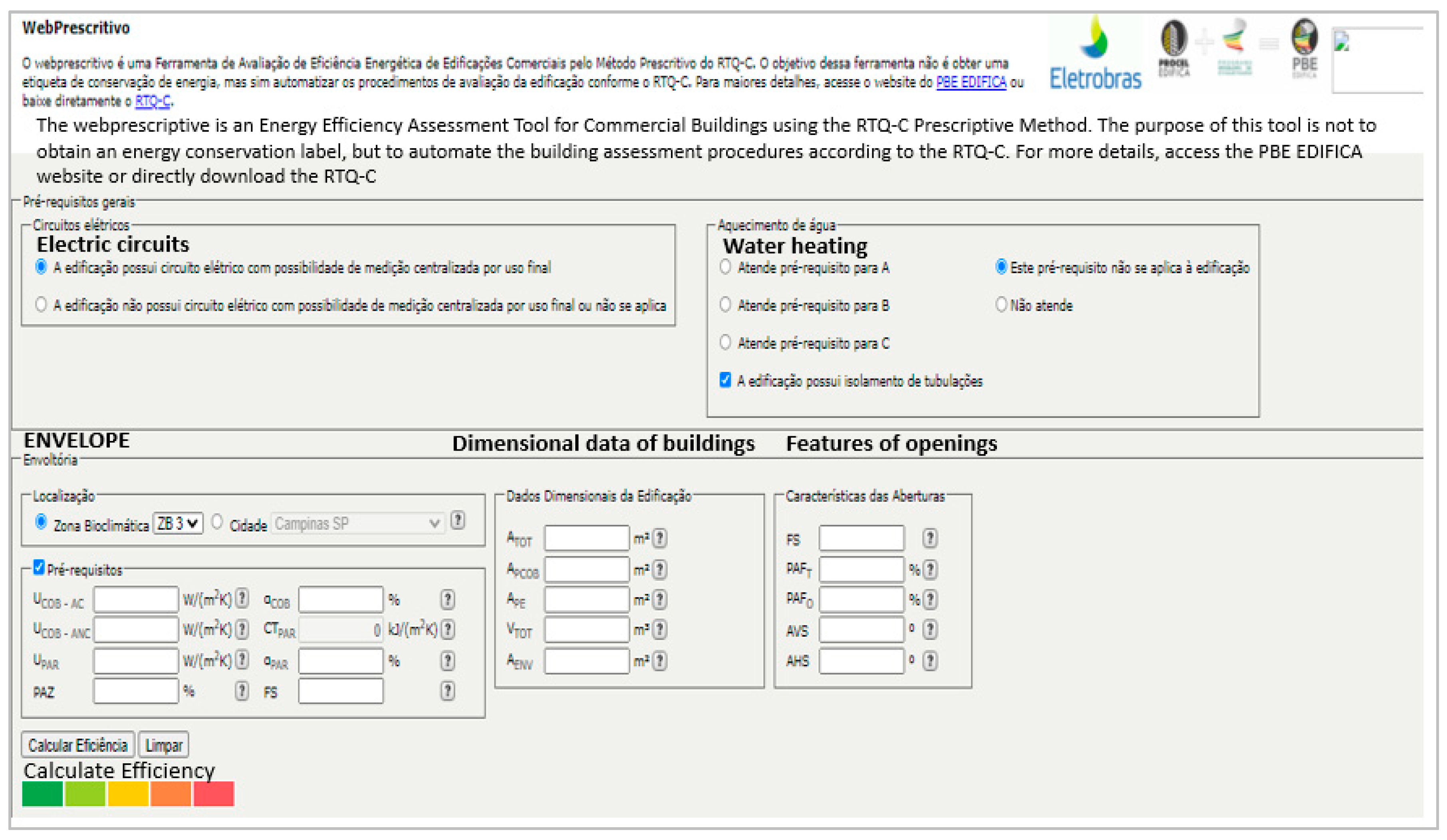

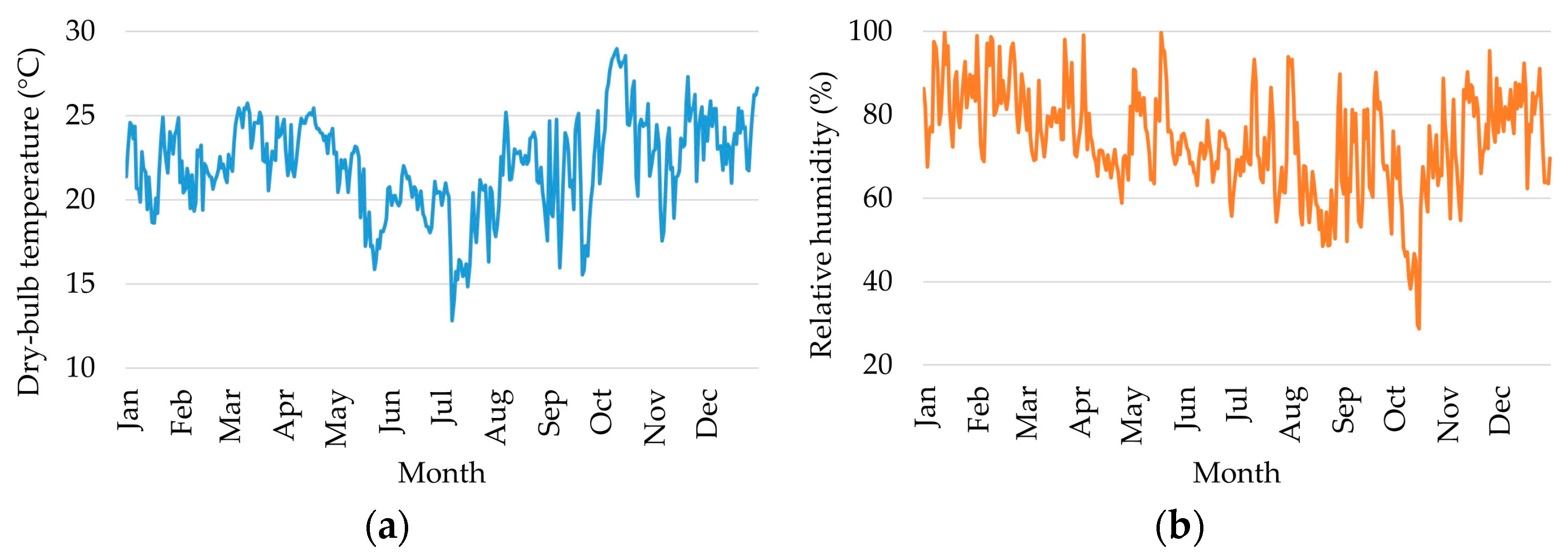
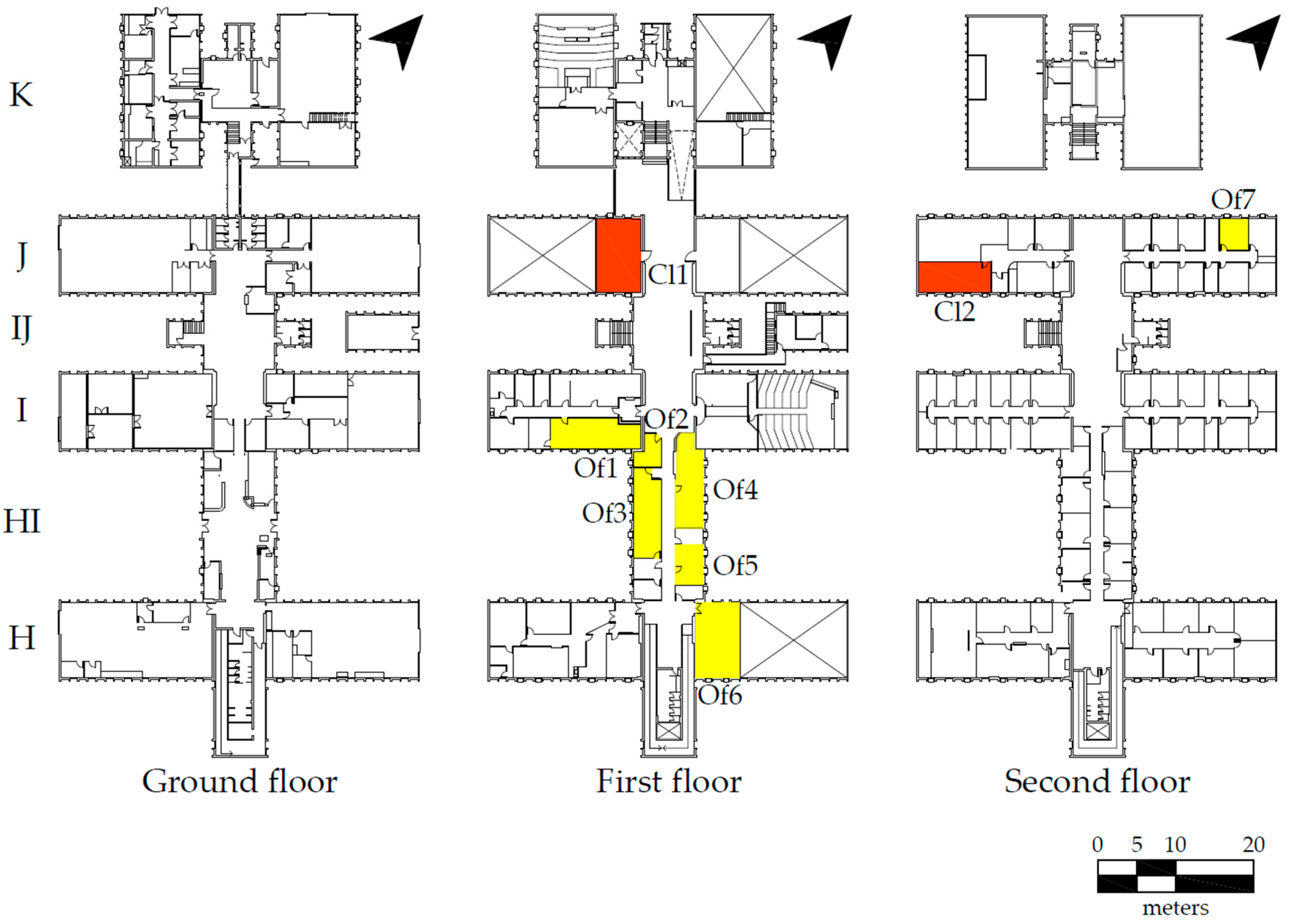

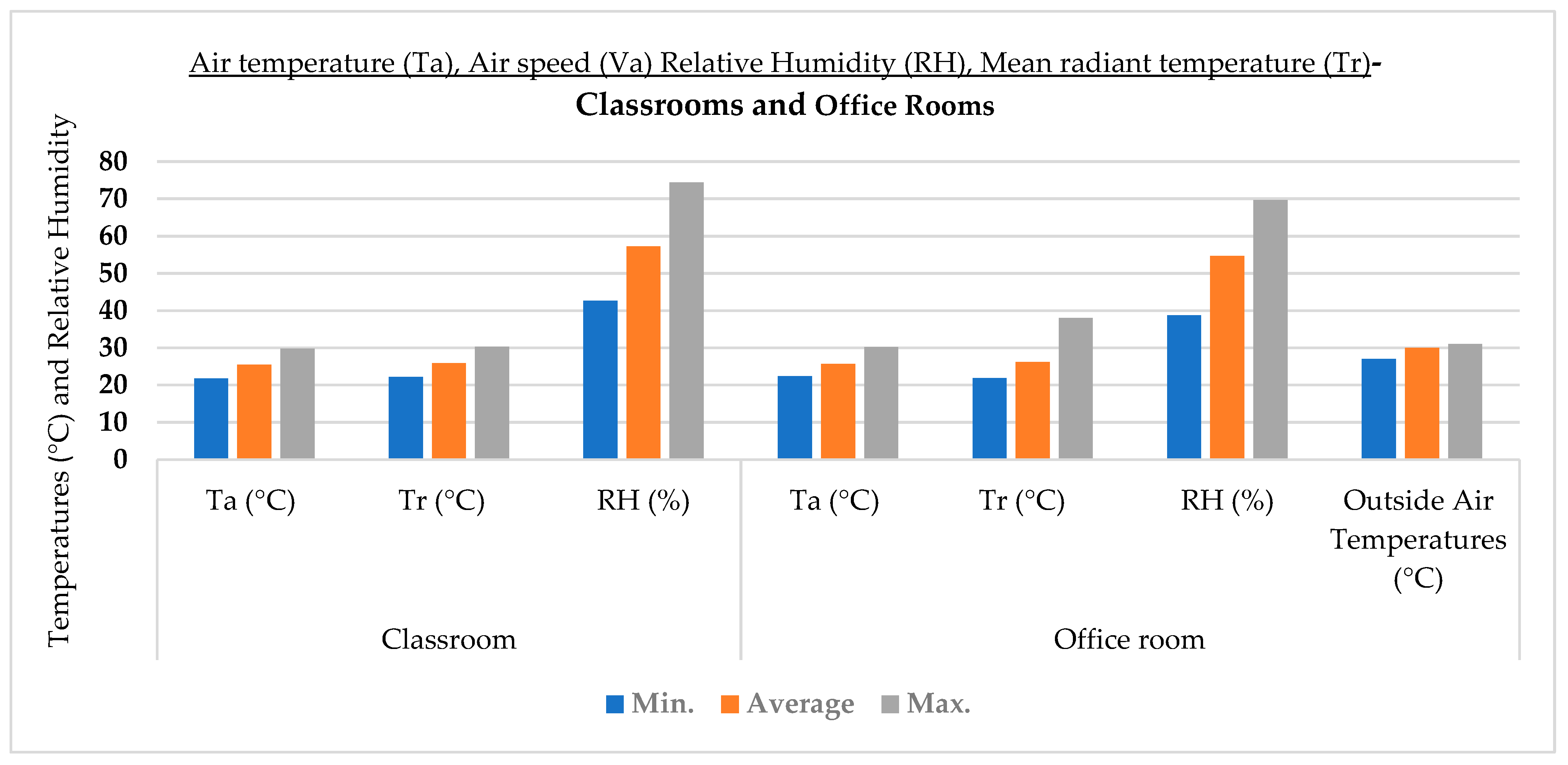
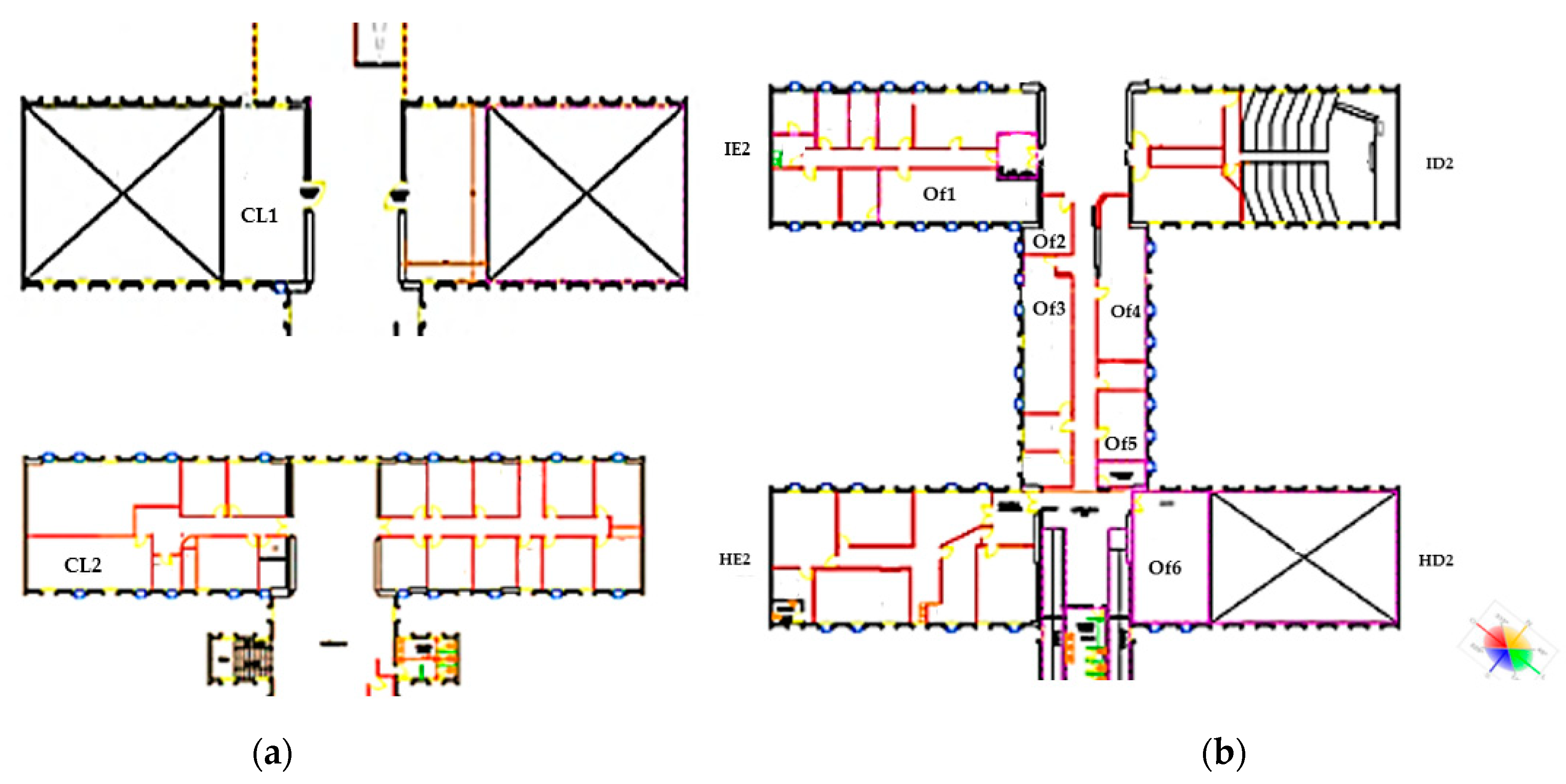

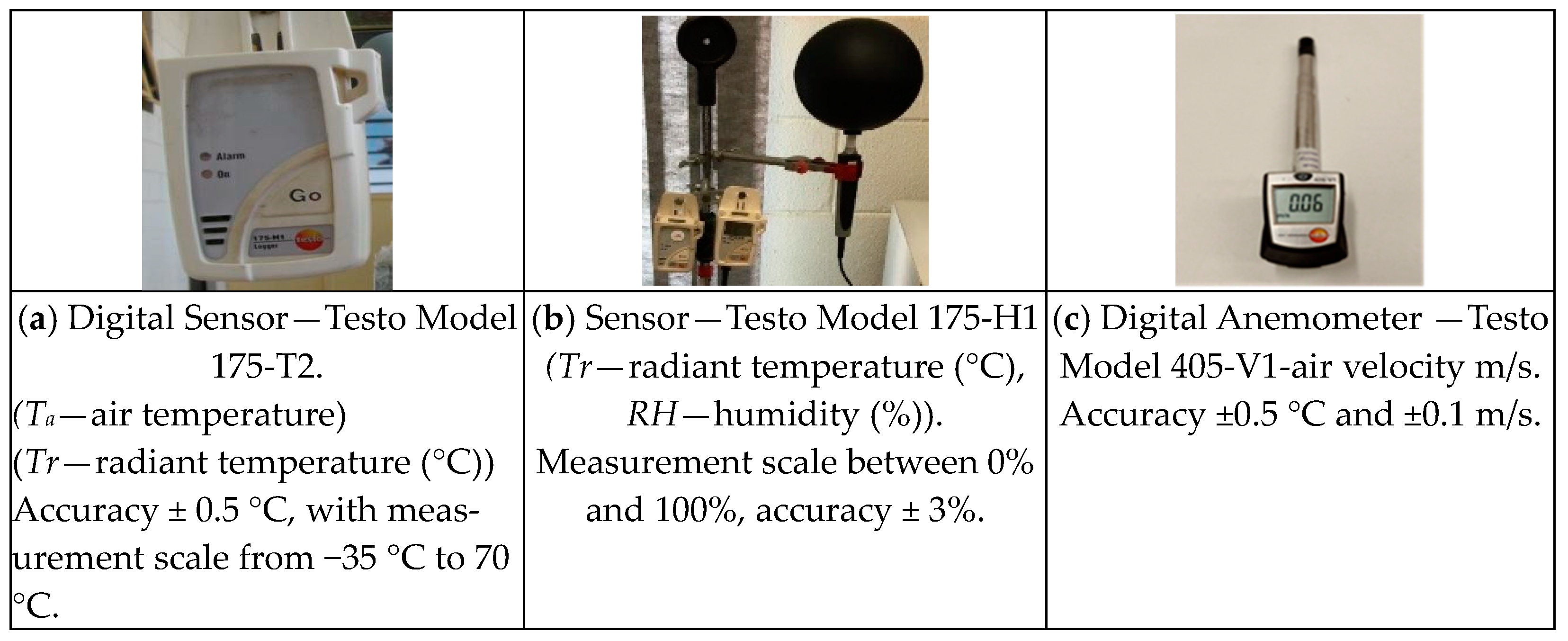
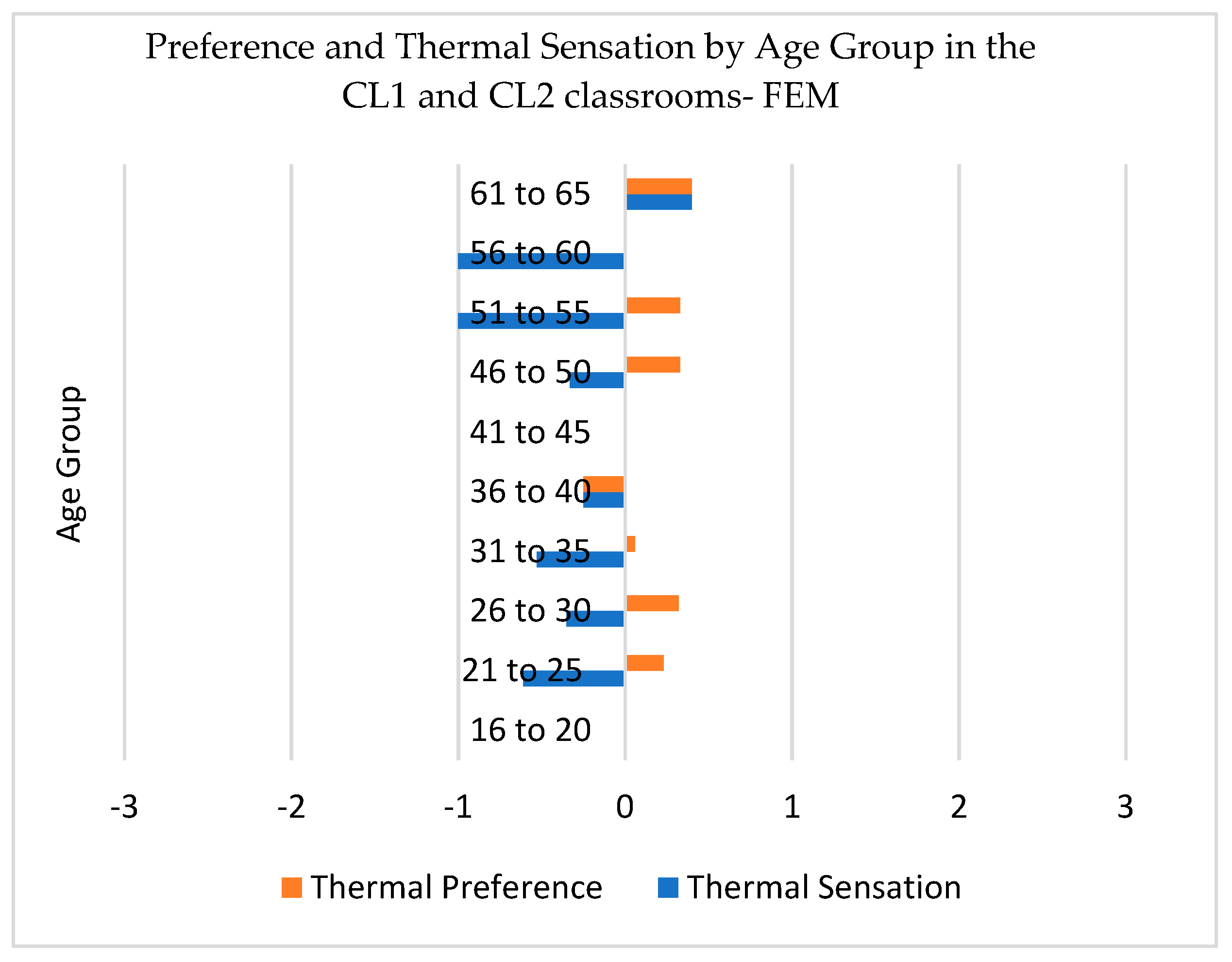
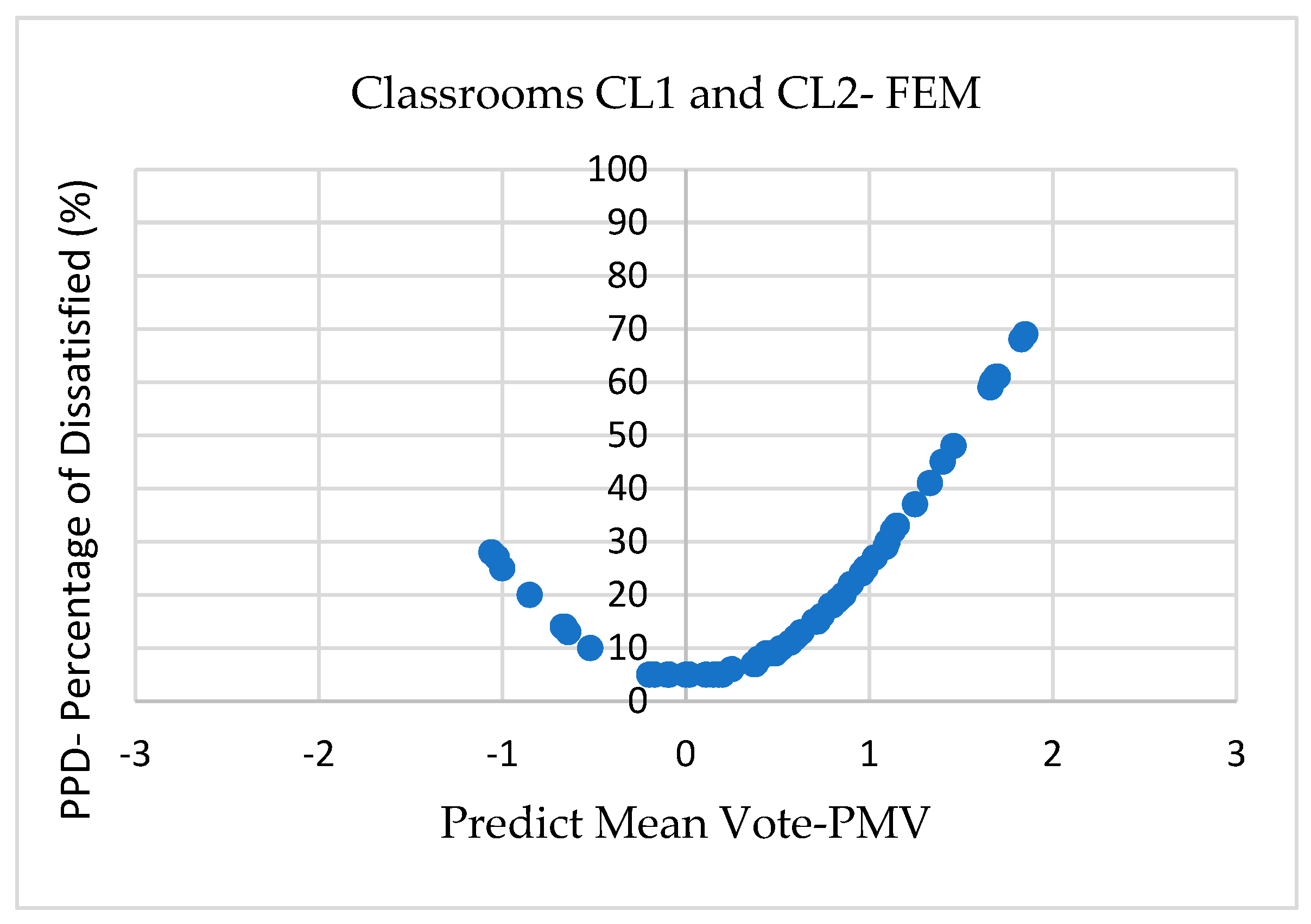

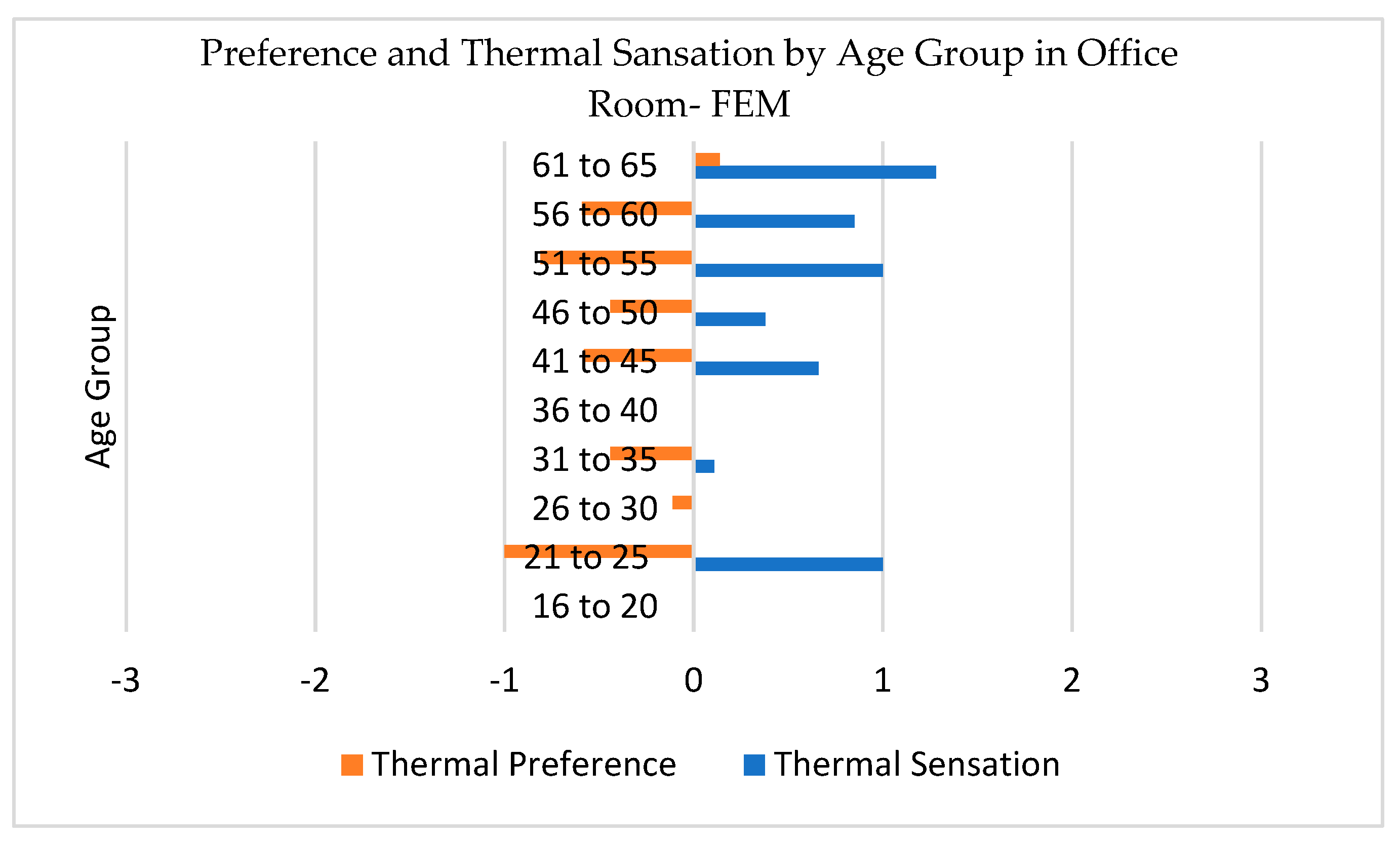
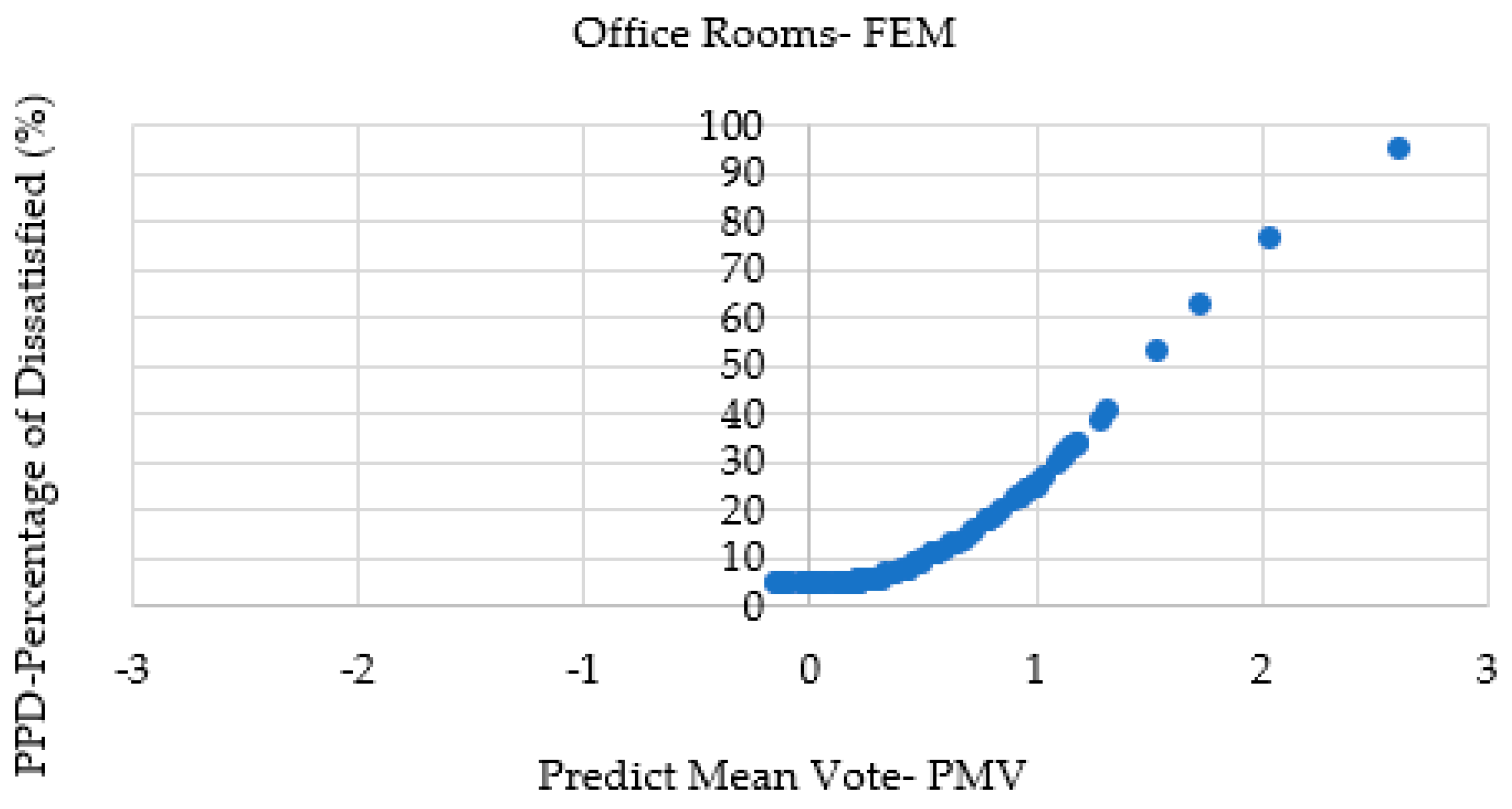
| Total Score (PT) | Final Label |
|---|---|
| 5 to PT ≥ 4.5 | A |
| 4.5 > PT ≥ 3.5 | B |
| 3.5 > PT ≥ 2.5 | C |
| 2.5 > PT ≥ 1.5 | D |
| PT < 1.5 | E |
| Element | Properties |
|---|---|
| External walls | Exterior plaster (25 mm)/concrete block (90 mm)/interior plaster (25 mm) (U1 = 2.92 W/m2K|α2 = 0.52) |
| Floors | Concrete slab (30 mm)/mortar (25 mm)/tile (10 mm) |
| Internal ceilings | Plaster (15 mm)/concrete slab (70 mm)/air gap/gypsum liner (10 mm) |
| Roof | Concrete slab (100 mm)/air gap/fibre cement tile (8 mm) (U1 = 2.06 W/m2K|α2 = 0.52) |
| Windows | Simple glazing (U1 = 5.80 W/m2K|SHGC3 = 0.80) |
| Room | Area (m2) | Floor Level | Orientation | Window-to-Wall Ratio (%) | HVAC | Total of Users in the Environment | Number of Responded Questionnaires |
|---|---|---|---|---|---|---|---|
| CL1 | 54.4 | 1st | NW-SE | 22.73 | S | 52 | 52 |
| CL2 | 37.1 | 2nd | SE | 22.73 | S | 45 | 45 |
| OF1 | 43.3 | 1st | SE | 22.73 | W | 3 | 10 |
| OF2 | 12.1 | 1st | SW | 77.5 | W | 4 | 16 |
| OF3 | 39.8 | 1st | SW | 77.75 | W | 5 | 21 |
| OF4 | 39.6 | 1st | NE | 77.75 | W | 3 | 12 |
| OF5 | 18.4 | 1st | NE | 77.75 | W | 3 | 12 |
| OF6 | 54.3 | 1st | SE | 17.2 | W | 4 | 16 |
| OF7 | 15.4 | 2nd | NW | 17.2 | W | 4 | 16 |
| Building | Room | Data Collection Period | Period of the Day | Minimum Sample Size (n) | Selected Sample Size (N) |
|---|---|---|---|---|---|
| FEM | Classrooms | ||||
| CL1 | 13, 14 Nov. 2018 | morning | 32.4 | 36 | |
| afternoon | 15.3 | 16 | |||
| CL2 | 13, 14 Nov. 2018 | morning | 24.9 | 27 | |
| afternoon | 17.1 | 18 | |||
| Offices | |||||
| Of. 3, 4 | 13, 14 Nov. 2018 | morning | 19.7 | 21 | |
| afternoon | 12.5 | 13 | |||
| Of. 6, 7 | 13, 14 Nov. 2018 | morning | 9.7 | 10 | |
| afternoon | 13.4 | 14 | |||
| Of. 1, 5, 2 | 13, 14 Dec. 2018 | morning | 9.7 | 10 | |
| afternoon | 13.4 | 14 | |||
| Block | H | I | J | K | HI | IJ |
| Envelope | C | C | C | C | D | D |
| Lighting | B | B | B | C | B | B |
| Air conditioning | C | D | E | D | E | E |
| Score | 2.68 | 3.87 | 3.03 | 3.44 | 2.22 | 2.38 |
| General level | C | B | C | C | D | D |
| Classroom | Total Questionnaires Answered | Percentage (%) | Average Age (Years) |
|---|---|---|---|
| Questionnaires Answered | 97 | 100 | --- |
| CL1 | 52 | 53% | --- |
| Cl2 | 45 | 46% | --- |
| Women | 33 | 34% | 29.4 |
| Men | 64 | 66% | 35.5 |
| CL1 | PMV | PPD | (Icl-Clo) |
|---|---|---|---|
| Average | 0.22 | 16.10 | 0.49 |
| Standard Deviation | 0.71 | 7.42 | 0.13 |
| Coefficient of Variation (%) | 322% | 46% | 26% |
| CL2 | PMV | PPD | (Icl-Clo) |
|---|---|---|---|
| Average | 0.09 | 28 | 0.50 |
| Standard Deviation | 0.80 | 23 | 0.12 |
| Coefficient of Variation (%) | 888% | 82% | 24% |
| Data | 9:00 a.m. | 11:30 a.m. | 2:00 p.m. | 4:30 p.m. |
|---|---|---|---|---|
| TBS inside—CL1 | 26.2 °C | 21.7 °C | 24.1 °C | 26.2 °C |
| Tar outside | 27.7 °C | 30.65 °C | 31.5 °C | 32 °C |
| TBS inside—CL2 | 28 °C | 25.7 °C | 30.2 °C | 23.5 °C |
| Office Rooms | Total | Percentage (%) | Average Age (Years) |
|---|---|---|---|
| Questionnaires returned | 102 | 100 | 47 |
| Woman | 63 | 62% | 45.7 |
| Man | 39 | 38% | 49.2 |
| Office | PMV | PPD (%) | Iclo-clo |
|---|---|---|---|
| Average | 0.52 | 14.59 | 0.48 |
| Standard Deviation | 0.49 | 15.28 | 0.12 |
| Coefficient of Variation (%) | 94.23 | 104.73 | 25 |
| Ta | 9:00 a.m. | 11:30 a.m. | 2:00 p.m. | 4:30 p.m. |
|---|---|---|---|---|
| Average air temperature (Ta) outside | 27.7 | 30.65 | 31.5 | 30.9 |
| Average Ta inside | 25.81 | 25 | 25.75 | 26 |
Disclaimer/Publisher’s Note: The statements, opinions and data contained in all publications are solely those of the individual author(s) and contributor(s) and not of MDPI and/or the editor(s). MDPI and/or the editor(s) disclaim responsibility for any injury to people or property resulting from any ideas, methods, instructions or products referred to in the content. |
© 2024 by the authors. Licensee MDPI, Basel, Switzerland. This article is an open access article distributed under the terms and conditions of the Creative Commons Attribution (CC BY) license (https://creativecommons.org/licenses/by/4.0/).
Share and Cite
Barbosa, E.F.T.; Labaki, L.C.; Castro, A.P.A.S.; Lopes, F.S.D. Energy Efficiency and Thermal Comfort Analysis in a Higher Education Building in Brazil. Sustainability 2024, 16, 462. https://doi.org/10.3390/su16010462
Barbosa EFT, Labaki LC, Castro APAS, Lopes FSD. Energy Efficiency and Thermal Comfort Analysis in a Higher Education Building in Brazil. Sustainability. 2024; 16(1):462. https://doi.org/10.3390/su16010462
Chicago/Turabian StyleBarbosa, Elisabeti F. T., Lucila C. Labaki, Adriana P. A. S. Castro, and Felipe S. D. Lopes. 2024. "Energy Efficiency and Thermal Comfort Analysis in a Higher Education Building in Brazil" Sustainability 16, no. 1: 462. https://doi.org/10.3390/su16010462
APA StyleBarbosa, E. F. T., Labaki, L. C., Castro, A. P. A. S., & Lopes, F. S. D. (2024). Energy Efficiency and Thermal Comfort Analysis in a Higher Education Building in Brazil. Sustainability, 16(1), 462. https://doi.org/10.3390/su16010462








